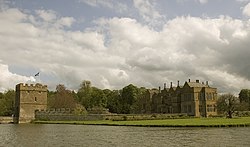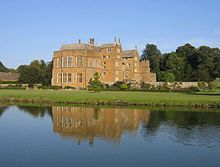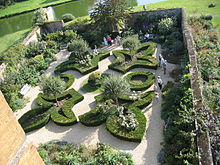Broughton Castle: Difference between revisions
Created page with "{{Infobox castle |name=Broughton Castle |county=Oxfordshire |picture=Broughton castle4.jpg |picture caption=Broughton Castle |os grid ref=SP418382 |latitude=52.04063 |longitud..." |
m clean up, typos fixed: As a result → As a result, |
||
| Line 26: | Line 26: | ||
[[File:Broughton castle1.jpg|thumb|220px|The Gatehouse]] | [[File:Broughton castle1.jpg|thumb|220px|The Gatehouse]] | ||
[[File:Broughton castle garden.jpg|thumb|220px|Formal garden]] | [[File:Broughton castle garden.jpg|thumb|220px|Formal garden]] | ||
In the 17th century, James I stayed at Broughton Castle on several occasions. After his time however William Fiennes, 1st Viscount Saye and Sele was one of the leading agitators against King Charles I. As a result the castle was used by Parliamentarian sympathisers,<ref name=OSCASTLE>{{cite book|title=Guide to Castles in Britain|last1=Furtado|first1=Peter|last2=Geddes|first2=Candida|last3=Harris|first3=Nathaniel|last4=Harrison|first4=Hazel|last5=Pettit|first5=Paul|publisher=Hamlyn – Ordnance Survey|date=1987|isbn=9780600558699|page=138|work=reference to Puritan and Parliamentary meeting of like minded people at the castle before the battle at Edgehill}}</ref> such as John Pym and John Hampden, as a meeting place in the decade leading up to the Civil War. The 1st Viscount raised troops to fight against the king at the inconclusive Battle of Edgehill in 1642. In the following days, Royalist troops besieged the castle, quickly overcoming the defenders and occupying the castle for a time. Following the end of hostilities, reconstruction work needed to be undertaken to repair damage inflicted by Royalist cannon. | In the 17th century, James I stayed at Broughton Castle on several occasions. After his time however William Fiennes, 1st Viscount Saye and Sele was one of the leading agitators against King Charles I. As a result, the castle was used by Parliamentarian sympathisers,<ref name=OSCASTLE>{{cite book|title=Guide to Castles in Britain|last1=Furtado|first1=Peter|last2=Geddes|first2=Candida|last3=Harris|first3=Nathaniel|last4=Harrison|first4=Hazel|last5=Pettit|first5=Paul|publisher=Hamlyn – Ordnance Survey|date=1987|isbn=9780600558699|page=138|work=reference to Puritan and Parliamentary meeting of like minded people at the castle before the battle at Edgehill}}</ref> such as John Pym and John Hampden, as a meeting place in the decade leading up to the Civil War. The 1st Viscount raised troops to fight against the king at the inconclusive Battle of Edgehill in 1642. In the following days, Royalist troops besieged the castle, quickly overcoming the defenders and occupying the castle for a time. Following the end of hostilities, reconstruction work needed to be undertaken to repair damage inflicted by Royalist cannon. | ||
Broughton fell into decay in the 19th century, but was eventually rescued by Frederick Fiennes, 16th Lord Saye and Sele, who brought in the prominent Victorian architect Sir George Gilbert Scott. At the turn of the century the house was rented by the Edwardian socialite Lady Algernon Gordon-Lennox, who transformed the gardens <ref>{{cite web|title=The Garden|url=http://www.broughtoncastle.com/the-garden-broughton-castle/|publisher=Broughton Castle}}</ref> and hosted King Edward VII at the castle. | Broughton fell into decay in the 19th century, but was eventually rescued by Frederick Fiennes, 16th Lord Saye and Sele, who brought in the prominent Victorian architect Sir George Gilbert Scott. At the turn of the century the house was rented by the Edwardian socialite Lady Algernon Gordon-Lennox, who transformed the gardens <ref>{{cite web|title=The Garden|url=http://www.broughtoncastle.com/the-garden-broughton-castle/|publisher=Broughton Castle}}</ref> and hosted King Edward VII at the castle. | ||
Latest revision as of 18:02, 30 January 2016
| Broughton Castle | |
|
Oxfordshire | |
|---|---|
 Broughton Castle | |
| Type: | Country house |
| Location | |
| Grid reference: | SP418382 |
| Location: | 52°2’26"N, 1°23’31"W |
| History | |
| Information | |
| Condition: | Good |
| Owned by: | Lord Saye and Sele |
| Website: | broughtoncastle.com |
Broughton Castle is a mediæval manor house in Broughton in Oxfordshire, about two miles southwest of Banbury on the B4035 road.
The castle is the home of the Fiennes family, Barons Saye and Sele. The castle sits in parkland and is surrounded by a wide moat.
History
The castle was built as a manor house by Sir John de Broughton in 1300 at a location where the confluence of three streams created a natural site for a moated manor. The house was sold in 1377 to William of Wykeham, Bishop of Winchester, and has remained in the same family since that time. The original house was crenellated by Sir Thomas Wykeham in 1406. In 1451 it passed by inheritance to the Fiennes family, Barons Saye and Sele.
Beginning in 1550 Richard Fiennes transformed the mediæval manor into a house in the Tudor style, significantly expanding the building.[1]




In the 17th century, James I stayed at Broughton Castle on several occasions. After his time however William Fiennes, 1st Viscount Saye and Sele was one of the leading agitators against King Charles I. As a result, the castle was used by Parliamentarian sympathisers,[2] such as John Pym and John Hampden, as a meeting place in the decade leading up to the Civil War. The 1st Viscount raised troops to fight against the king at the inconclusive Battle of Edgehill in 1642. In the following days, Royalist troops besieged the castle, quickly overcoming the defenders and occupying the castle for a time. Following the end of hostilities, reconstruction work needed to be undertaken to repair damage inflicted by Royalist cannon.
Broughton fell into decay in the 19th century, but was eventually rescued by Frederick Fiennes, 16th Lord Saye and Sele, who brought in the prominent Victorian architect Sir George Gilbert Scott. At the turn of the century the house was rented by the Edwardian socialite Lady Algernon Gordon-Lennox, who transformed the gardens [3] and hosted King Edward VII at the castle.
It is still the home of the Fiennes family and currently lived in by the 21st Baron and his wife. It opens to the public over the summer.
Filming
Films which have used Boughton Castle as a location include:
- Oxford Blues (1984)
- The Scarlet Pimpernel (1982)
- Three Men and a Little Lady (1990)
- The Madness of King George (1994)
- Shakespeare in Love (1998)
It has been used on television in:
- Elizabeth The Virgin Queen
- Friends and Crocodiles
- 1975 Morecambe and Wise Christmas Show
- The titles of Noel's House Party
- Jane Eyre (2011)
- Wolf Hall
Concerts
In August 1981, the electric folk band Fairport Convention held their Fairport's Cropredy Convention|annual reunion concert at Broughton Castle, rather than the usual Cropredy location.[4] The concert was recorded, and released on the album Moat on the Ledge (1982).
Fiction
Published in April 2009, The Music Room is a novel by William Fiennes. This fictionalized memoir of his childhood and his epileptic brother is set in (the never identified) Broughton Castle. It has been described as "a beautiful poem of a tribute to his family, his parents, the magical, moated castle that was his home".[5]
Outside links
| ("Wikimedia Commons" has material about Broughton Castle) |
References
- ↑ Fry, Plantagenet Somerset, The David & Charles Book of Castles, David & Charles, 1980. ISBN 0-7153-7976-3
- ↑ Furtado, Peter; Geddes, Candida; Harris, Nathaniel; Harrison, Hazel; Pettit, Paul (1987). Guide to Castles in Britain. Hamlyn – Ordnance Survey. p. 138. ISBN 9780600558699.
- ↑ "The Garden". Broughton Castle. http://www.broughtoncastle.com/the-garden-broughton-castle/.
- ↑ Humphries, Patrick (1982). Meet on the Ledge - a history of Fairport Convention. London: Eel Pie. p. 103. ISBN 0-906008-46-8.
- ↑ Scotland on Sunday: "Here be gargoyles: An interview with William Fiennes"
